Australia's Renewable Energy: A Comprehensive Overview
VerifiedAdded on 2024/05/27
|10
|1315
|170
AI Summary
This report provides a comprehensive overview of Australia's renewable energy sector, exploring the key sources of renewable energy, including hydropower, wind power, solar photovoltaics (PV), and bioenergy. It examines the current state of the sector, highlighting its growth, challenges, and potential. The report also delves into the economic and environmental impacts of renewable energy in Australia, analyzing its role in mitigating climate change and fostering sustainable development. Finally, it presents recommendations for further policy development and investment to accelerate the transition towards a cleaner and more sustainable energy future.
Contribute Materials
Your contribution can guide someone’s learning journey. Share your
documents today.

Australia’s stand on Renewable energy
Secure Best Marks with AI Grader
Need help grading? Try our AI Grader for instant feedback on your assignments.
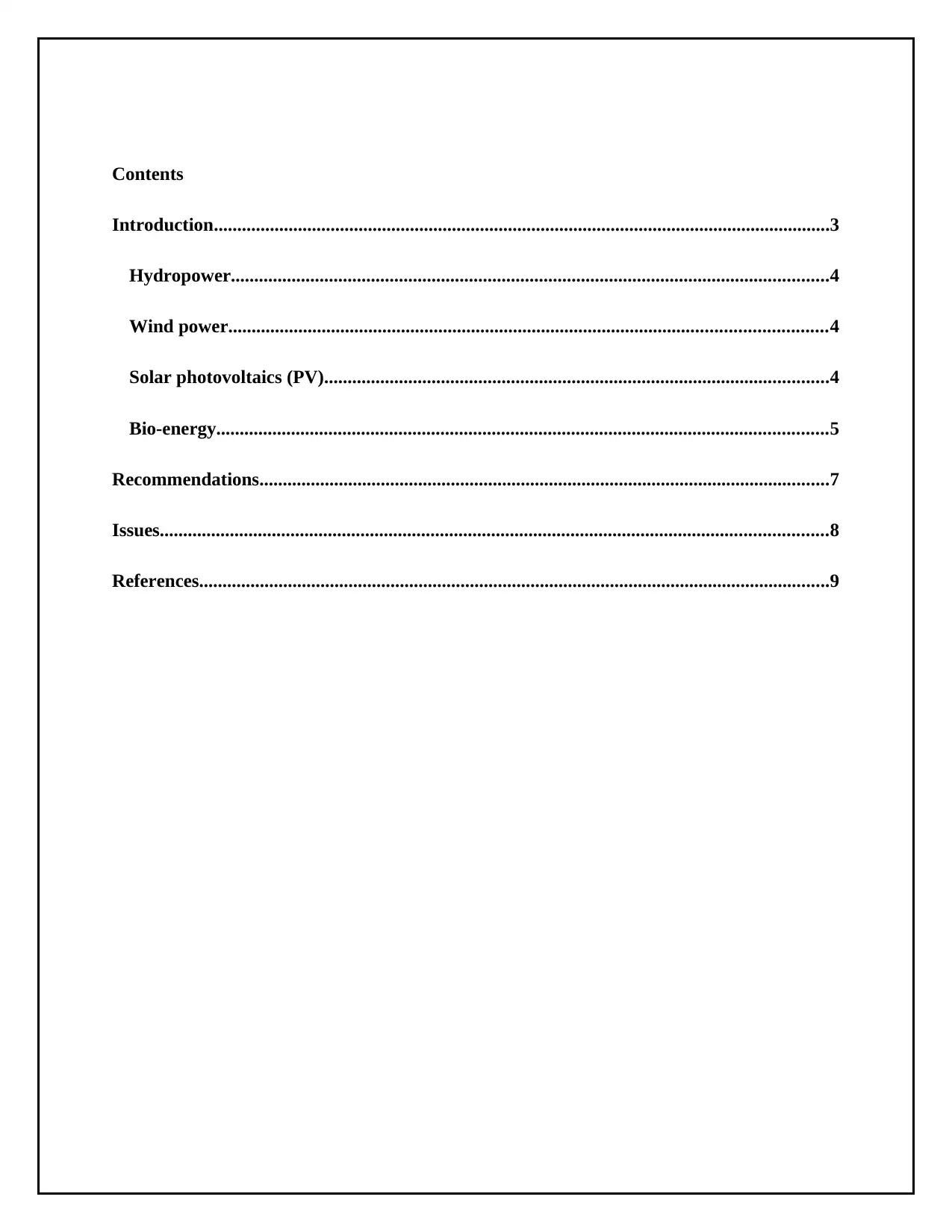
Contents
Introduction....................................................................................................................................3
Hydropower................................................................................................................................4
Wind power................................................................................................................................4
Solar photovoltaics (PV)............................................................................................................4
Bio-energy...................................................................................................................................5
Recommendations..........................................................................................................................7
Issues...............................................................................................................................................8
References.......................................................................................................................................9
Introduction....................................................................................................................................3
Hydropower................................................................................................................................4
Wind power................................................................................................................................4
Solar photovoltaics (PV)............................................................................................................4
Bio-energy...................................................................................................................................5
Recommendations..........................................................................................................................7
Issues...............................................................................................................................................8
References.......................................................................................................................................9
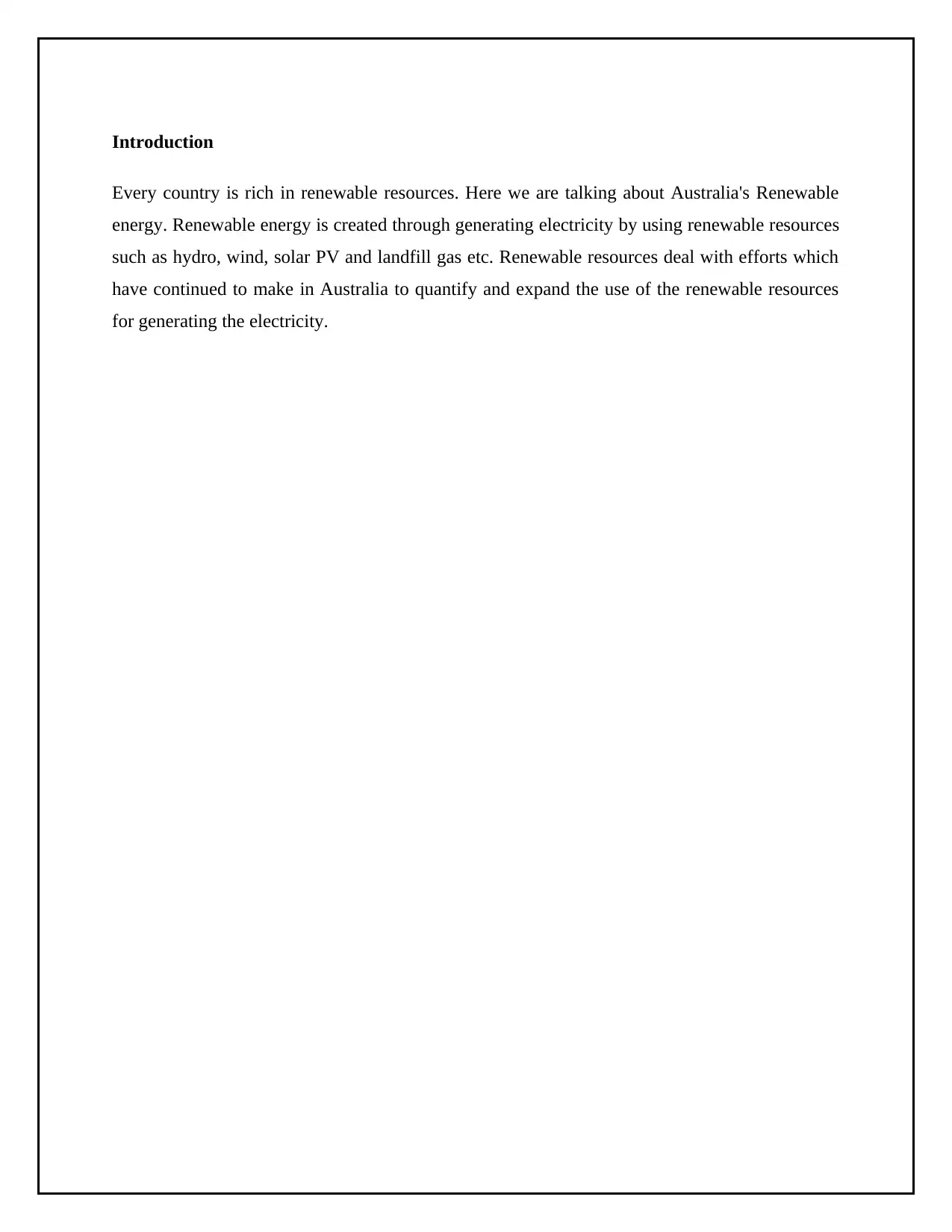
Introduction
Every country is rich in renewable resources. Here we are talking about Australia's Renewable
energy. Renewable energy is created through generating electricity by using renewable resources
such as hydro, wind, solar PV and landfill gas etc. Renewable resources deal with efforts which
have continued to make in Australia to quantify and expand the use of the renewable resources
for generating the electricity.
Every country is rich in renewable resources. Here we are talking about Australia's Renewable
energy. Renewable energy is created through generating electricity by using renewable resources
such as hydro, wind, solar PV and landfill gas etc. Renewable resources deal with efforts which
have continued to make in Australia to quantify and expand the use of the renewable resources
for generating the electricity.
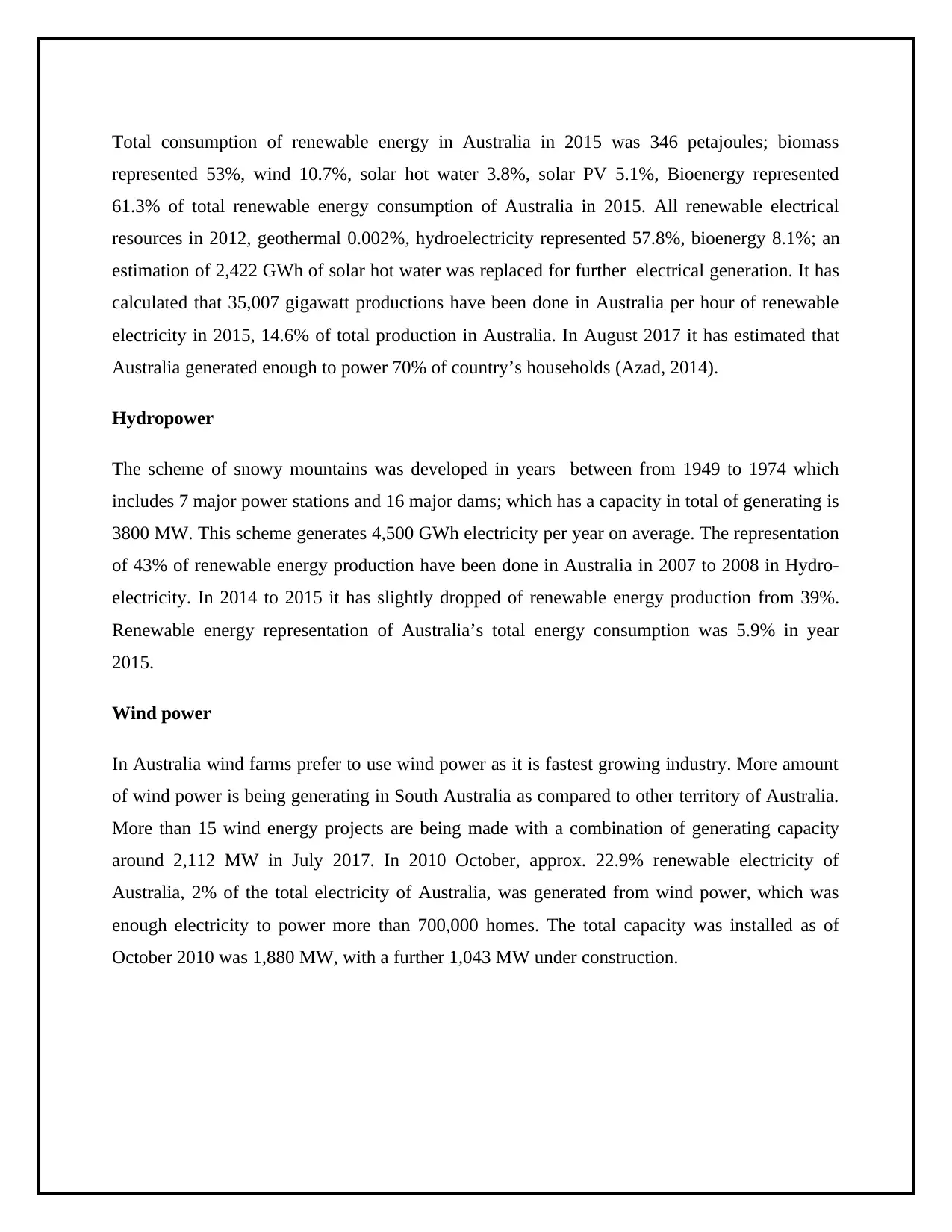
Total consumption of renewable energy in Australia in 2015 was 346 petajoules; biomass
represented 53%, wind 10.7%, solar hot water 3.8%, solar PV 5.1%, Bioenergy represented
61.3% of total renewable energy consumption of Australia in 2015. All renewable electrical
resources in 2012, geothermal 0.002%, hydroelectricity represented 57.8%, bioenergy 8.1%; an
estimation of 2,422 GWh of solar hot water was replaced for further electrical generation. It has
calculated that 35,007 gigawatt productions have been done in Australia per hour of renewable
electricity in 2015, 14.6% of total production in Australia. In August 2017 it has estimated that
Australia generated enough to power 70% of country’s households (Azad, 2014).
Hydropower
The scheme of snowy mountains was developed in years between from 1949 to 1974 which
includes 7 major power stations and 16 major dams; which has a capacity in total of generating is
3800 MW. This scheme generates 4,500 GWh electricity per year on average. The representation
of 43% of renewable energy production have been done in Australia in 2007 to 2008 in Hydro-
electricity. In 2014 to 2015 it has slightly dropped of renewable energy production from 39%.
Renewable energy representation of Australia’s total energy consumption was 5.9% in year
2015.
Wind power
In Australia wind farms prefer to use wind power as it is fastest growing industry. More amount
of wind power is being generating in South Australia as compared to other territory of Australia.
More than 15 wind energy projects are being made with a combination of generating capacity
around 2,112 MW in July 2017. In 2010 October, approx. 22.9% renewable electricity of
Australia, 2% of the total electricity of Australia, was generated from wind power, which was
enough electricity to power more than 700,000 homes. The total capacity was installed as of
October 2010 was 1,880 MW, with a further 1,043 MW under construction.
represented 53%, wind 10.7%, solar hot water 3.8%, solar PV 5.1%, Bioenergy represented
61.3% of total renewable energy consumption of Australia in 2015. All renewable electrical
resources in 2012, geothermal 0.002%, hydroelectricity represented 57.8%, bioenergy 8.1%; an
estimation of 2,422 GWh of solar hot water was replaced for further electrical generation. It has
calculated that 35,007 gigawatt productions have been done in Australia per hour of renewable
electricity in 2015, 14.6% of total production in Australia. In August 2017 it has estimated that
Australia generated enough to power 70% of country’s households (Azad, 2014).
Hydropower
The scheme of snowy mountains was developed in years between from 1949 to 1974 which
includes 7 major power stations and 16 major dams; which has a capacity in total of generating is
3800 MW. This scheme generates 4,500 GWh electricity per year on average. The representation
of 43% of renewable energy production have been done in Australia in 2007 to 2008 in Hydro-
electricity. In 2014 to 2015 it has slightly dropped of renewable energy production from 39%.
Renewable energy representation of Australia’s total energy consumption was 5.9% in year
2015.
Wind power
In Australia wind farms prefer to use wind power as it is fastest growing industry. More amount
of wind power is being generating in South Australia as compared to other territory of Australia.
More than 15 wind energy projects are being made with a combination of generating capacity
around 2,112 MW in July 2017. In 2010 October, approx. 22.9% renewable electricity of
Australia, 2% of the total electricity of Australia, was generated from wind power, which was
enough electricity to power more than 700,000 homes. The total capacity was installed as of
October 2010 was 1,880 MW, with a further 1,043 MW under construction.
Secure Best Marks with AI Grader
Need help grading? Try our AI Grader for instant feedback on your assignments.
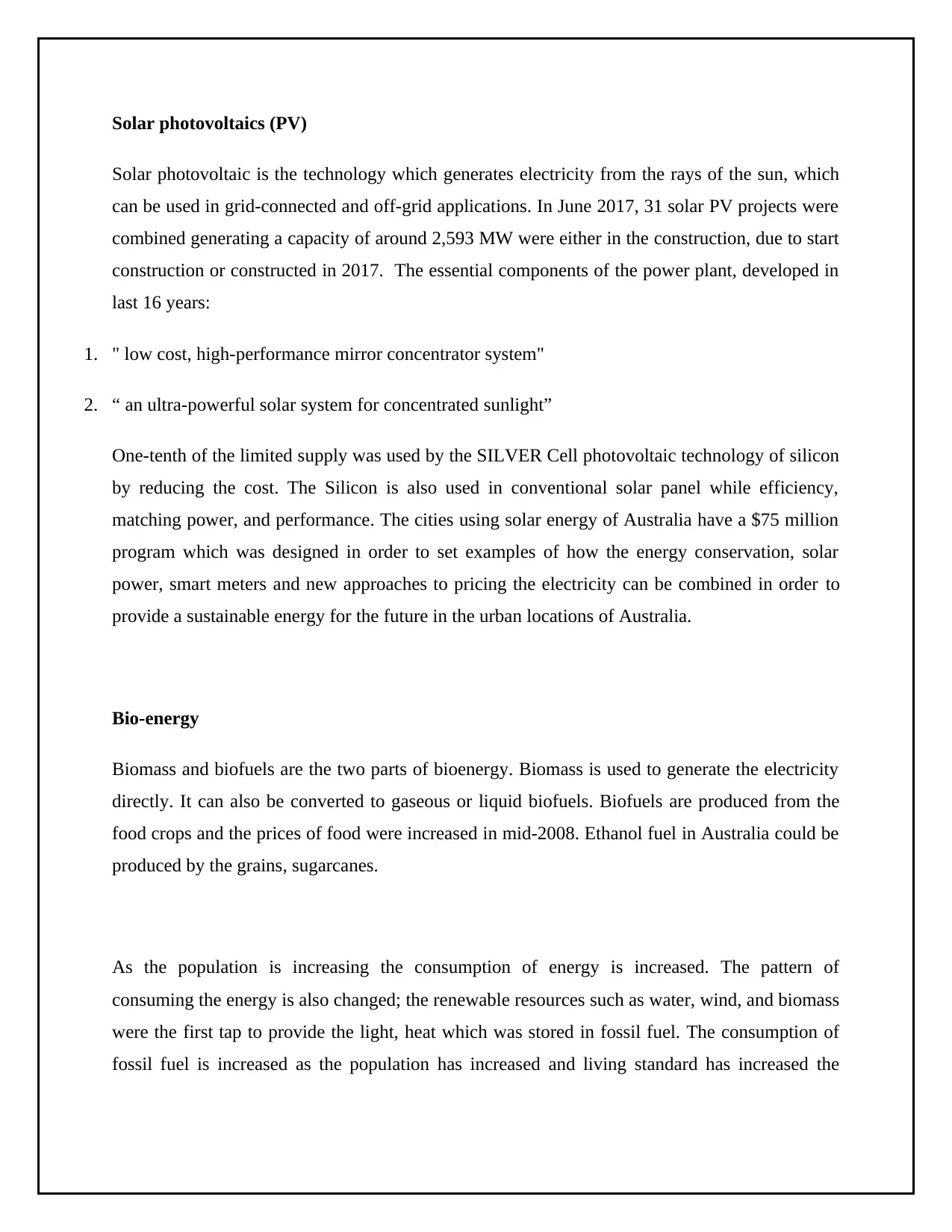
Solar photovoltaics (PV)
Solar photovoltaic is the technology which generates electricity from the rays of the sun, which
can be used in grid-connected and off-grid applications. In June 2017, 31 solar PV projects were
combined generating a capacity of around 2,593 MW were either in the construction, due to start
construction or constructed in 2017. The essential components of the power plant, developed in
last 16 years:
1. " low cost, high-performance mirror concentrator system"
2. “ an ultra-powerful solar system for concentrated sunlight”
One-tenth of the limited supply was used by the SILVER Cell photovoltaic technology of silicon
by reducing the cost. The Silicon is also used in conventional solar panel while efficiency,
matching power, and performance. The cities using solar energy of Australia have a $75 million
program which was designed in order to set examples of how the energy conservation, solar
power, smart meters and new approaches to pricing the electricity can be combined in order to
provide a sustainable energy for the future in the urban locations of Australia.
Bio-energy
Biomass and biofuels are the two parts of bioenergy. Biomass is used to generate the electricity
directly. It can also be converted to gaseous or liquid biofuels. Biofuels are produced from the
food crops and the prices of food were increased in mid-2008. Ethanol fuel in Australia could be
produced by the grains, sugarcanes.
As the population is increasing the consumption of energy is increased. The pattern of
consuming the energy is also changed; the renewable resources such as water, wind, and biomass
were the first tap to provide the light, heat which was stored in fossil fuel. The consumption of
fossil fuel is increased as the population has increased and living standard has increased the
Solar photovoltaic is the technology which generates electricity from the rays of the sun, which
can be used in grid-connected and off-grid applications. In June 2017, 31 solar PV projects were
combined generating a capacity of around 2,593 MW were either in the construction, due to start
construction or constructed in 2017. The essential components of the power plant, developed in
last 16 years:
1. " low cost, high-performance mirror concentrator system"
2. “ an ultra-powerful solar system for concentrated sunlight”
One-tenth of the limited supply was used by the SILVER Cell photovoltaic technology of silicon
by reducing the cost. The Silicon is also used in conventional solar panel while efficiency,
matching power, and performance. The cities using solar energy of Australia have a $75 million
program which was designed in order to set examples of how the energy conservation, solar
power, smart meters and new approaches to pricing the electricity can be combined in order to
provide a sustainable energy for the future in the urban locations of Australia.
Bio-energy
Biomass and biofuels are the two parts of bioenergy. Biomass is used to generate the electricity
directly. It can also be converted to gaseous or liquid biofuels. Biofuels are produced from the
food crops and the prices of food were increased in mid-2008. Ethanol fuel in Australia could be
produced by the grains, sugarcanes.
As the population is increasing the consumption of energy is increased. The pattern of
consuming the energy is also changed; the renewable resources such as water, wind, and biomass
were the first tap to provide the light, heat which was stored in fossil fuel. The consumption of
fossil fuel is increased as the population has increased and living standard has increased the
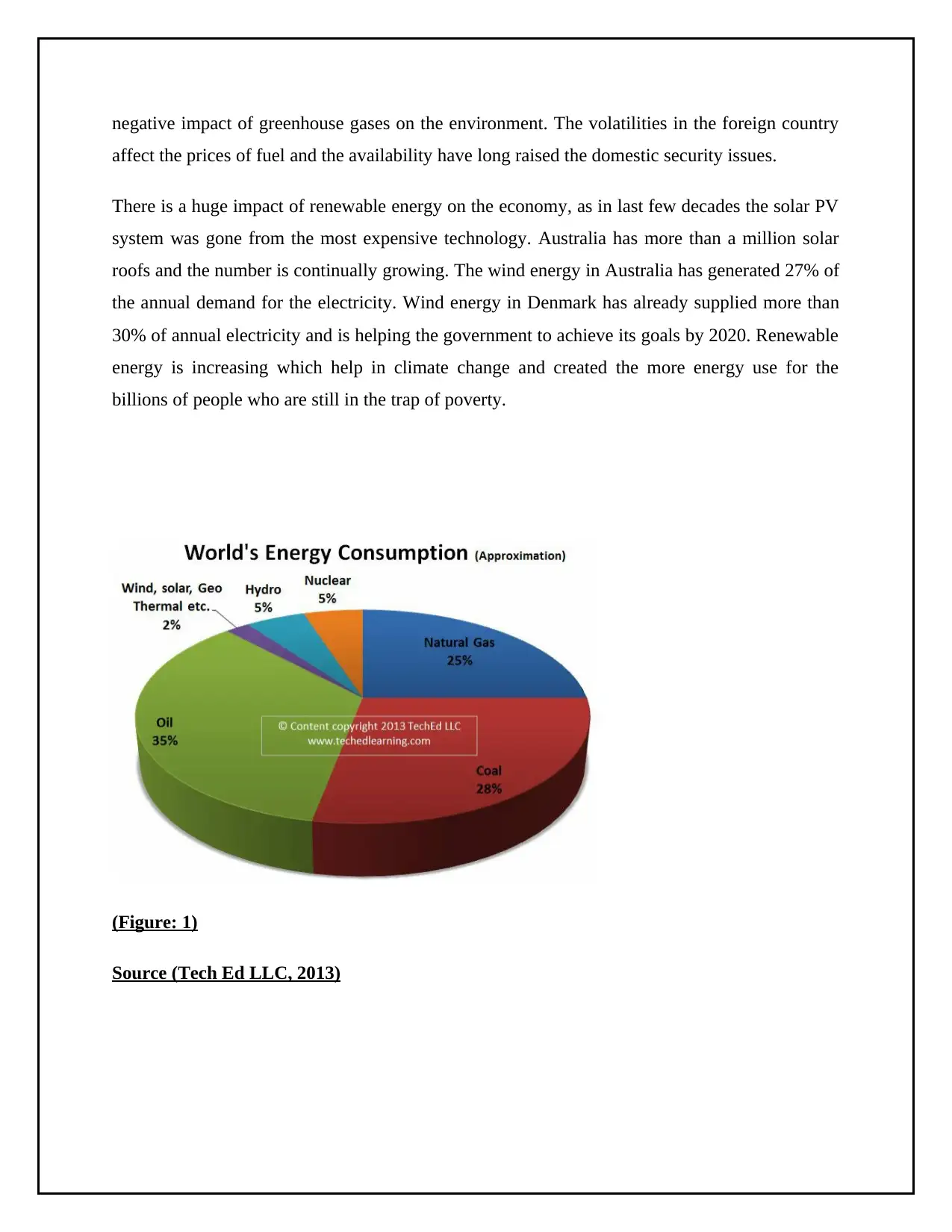
negative impact of greenhouse gases on the environment. The volatilities in the foreign country
affect the prices of fuel and the availability have long raised the domestic security issues.
There is a huge impact of renewable energy on the economy, as in last few decades the solar PV
system was gone from the most expensive technology. Australia has more than a million solar
roofs and the number is continually growing. The wind energy in Australia has generated 27% of
the annual demand for the electricity. Wind energy in Denmark has already supplied more than
30% of annual electricity and is helping the government to achieve its goals by 2020. Renewable
energy is increasing which help in climate change and created the more energy use for the
billions of people who are still in the trap of poverty.
(Figure: 1)
Source (Tech Ed LLC, 2013)
affect the prices of fuel and the availability have long raised the domestic security issues.
There is a huge impact of renewable energy on the economy, as in last few decades the solar PV
system was gone from the most expensive technology. Australia has more than a million solar
roofs and the number is continually growing. The wind energy in Australia has generated 27% of
the annual demand for the electricity. Wind energy in Denmark has already supplied more than
30% of annual electricity and is helping the government to achieve its goals by 2020. Renewable
energy is increasing which help in climate change and created the more energy use for the
billions of people who are still in the trap of poverty.
(Figure: 1)
Source (Tech Ed LLC, 2013)

Paraphrase This Document
Need a fresh take? Get an instant paraphrase of this document with our AI Paraphraser
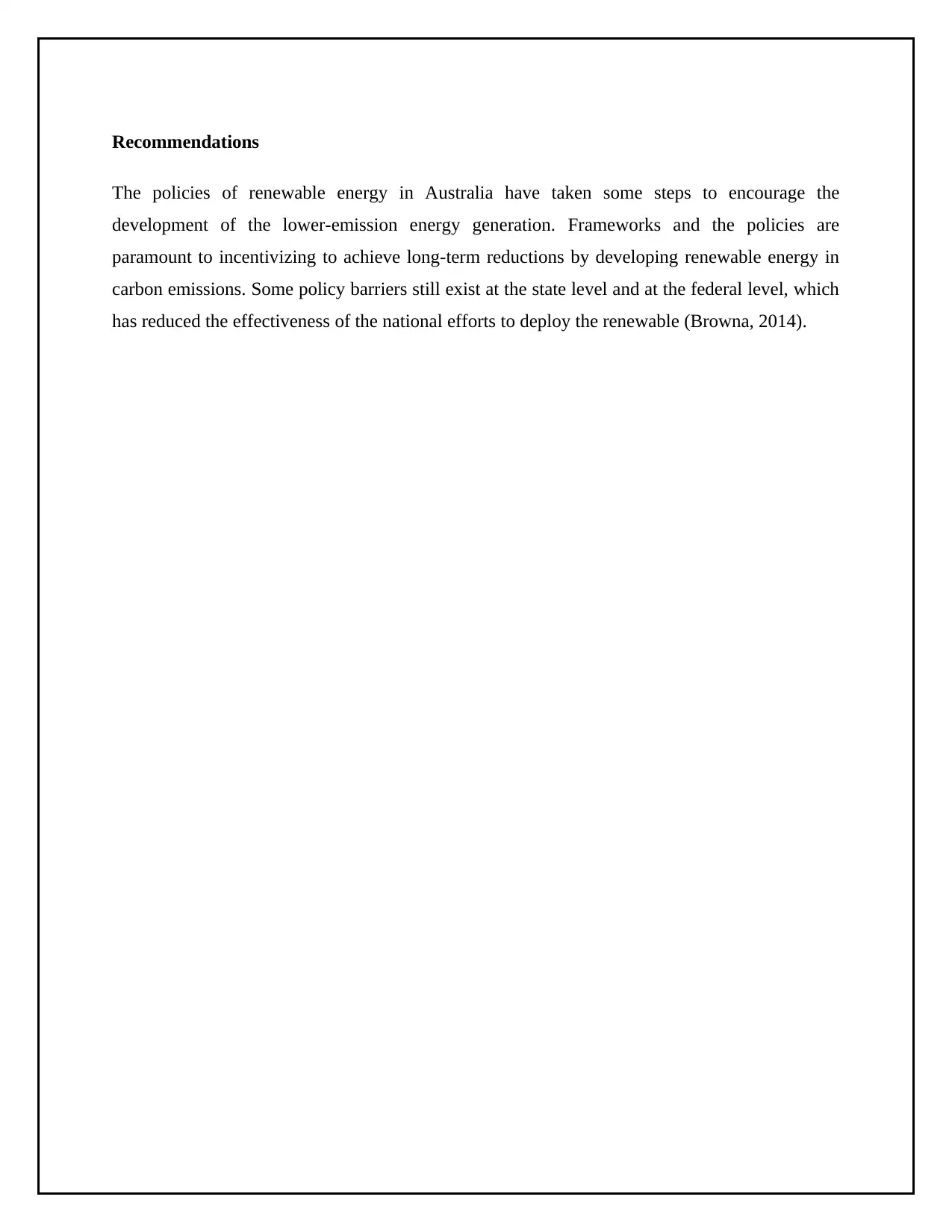
Recommendations
The policies of renewable energy in Australia have taken some steps to encourage the
development of the lower-emission energy generation. Frameworks and the policies are
paramount to incentivizing to achieve long-term reductions by developing renewable energy in
carbon emissions. Some policy barriers still exist at the state level and at the federal level, which
has reduced the effectiveness of the national efforts to deploy the renewable (Browna, 2014).
The policies of renewable energy in Australia have taken some steps to encourage the
development of the lower-emission energy generation. Frameworks and the policies are
paramount to incentivizing to achieve long-term reductions by developing renewable energy in
carbon emissions. Some policy barriers still exist at the state level and at the federal level, which
has reduced the effectiveness of the national efforts to deploy the renewable (Browna, 2014).
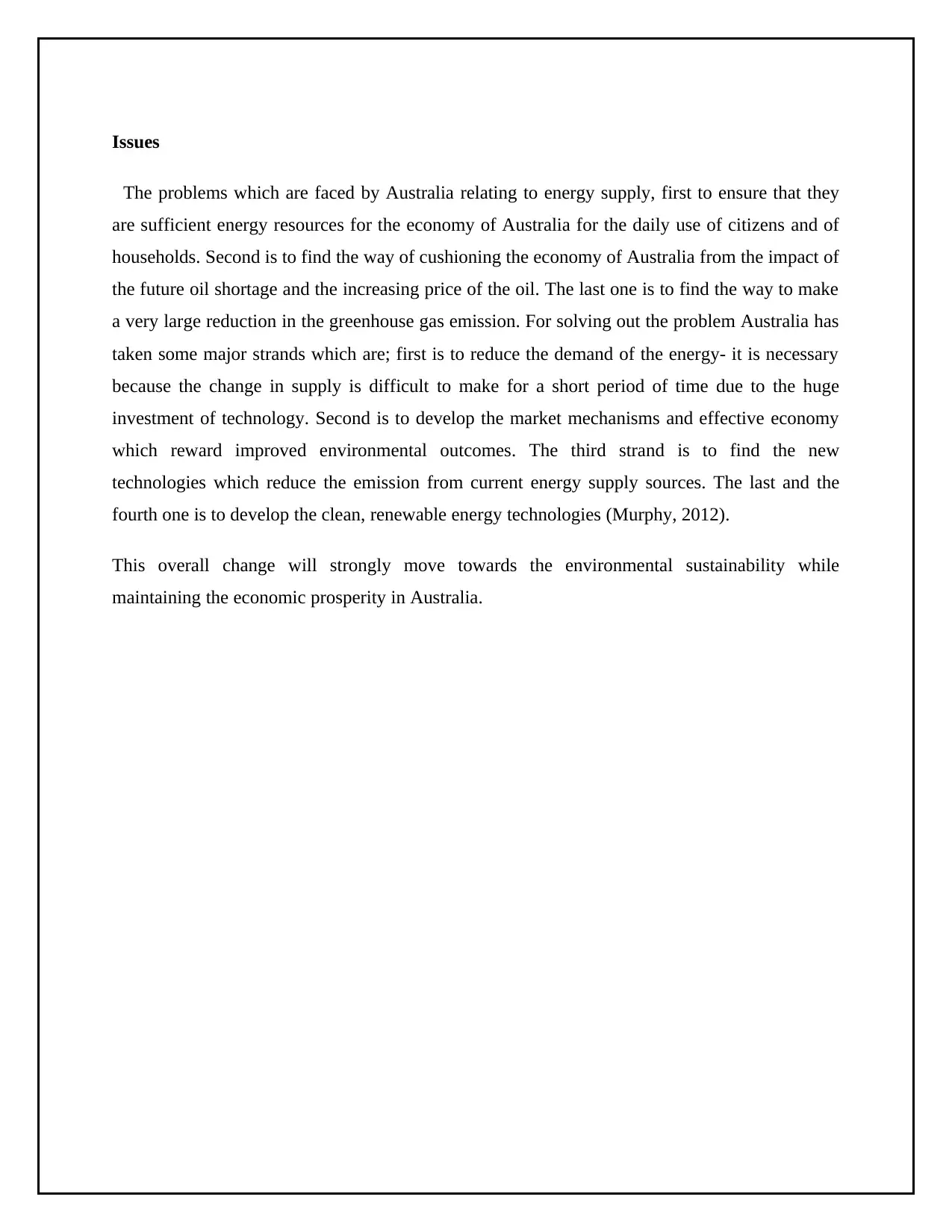
Issues
The problems which are faced by Australia relating to energy supply, first to ensure that they
are sufficient energy resources for the economy of Australia for the daily use of citizens and of
households. Second is to find the way of cushioning the economy of Australia from the impact of
the future oil shortage and the increasing price of the oil. The last one is to find the way to make
a very large reduction in the greenhouse gas emission. For solving out the problem Australia has
taken some major strands which are; first is to reduce the demand of the energy- it is necessary
because the change in supply is difficult to make for a short period of time due to the huge
investment of technology. Second is to develop the market mechanisms and effective economy
which reward improved environmental outcomes. The third strand is to find the new
technologies which reduce the emission from current energy supply sources. The last and the
fourth one is to develop the clean, renewable energy technologies (Murphy, 2012).
This overall change will strongly move towards the environmental sustainability while
maintaining the economic prosperity in Australia.
The problems which are faced by Australia relating to energy supply, first to ensure that they
are sufficient energy resources for the economy of Australia for the daily use of citizens and of
households. Second is to find the way of cushioning the economy of Australia from the impact of
the future oil shortage and the increasing price of the oil. The last one is to find the way to make
a very large reduction in the greenhouse gas emission. For solving out the problem Australia has
taken some major strands which are; first is to reduce the demand of the energy- it is necessary
because the change in supply is difficult to make for a short period of time due to the huge
investment of technology. Second is to develop the market mechanisms and effective economy
which reward improved environmental outcomes. The third strand is to find the new
technologies which reduce the emission from current energy supply sources. The last and the
fourth one is to develop the clean, renewable energy technologies (Murphy, 2012).
This overall change will strongly move towards the environmental sustainability while
maintaining the economic prosperity in Australia.
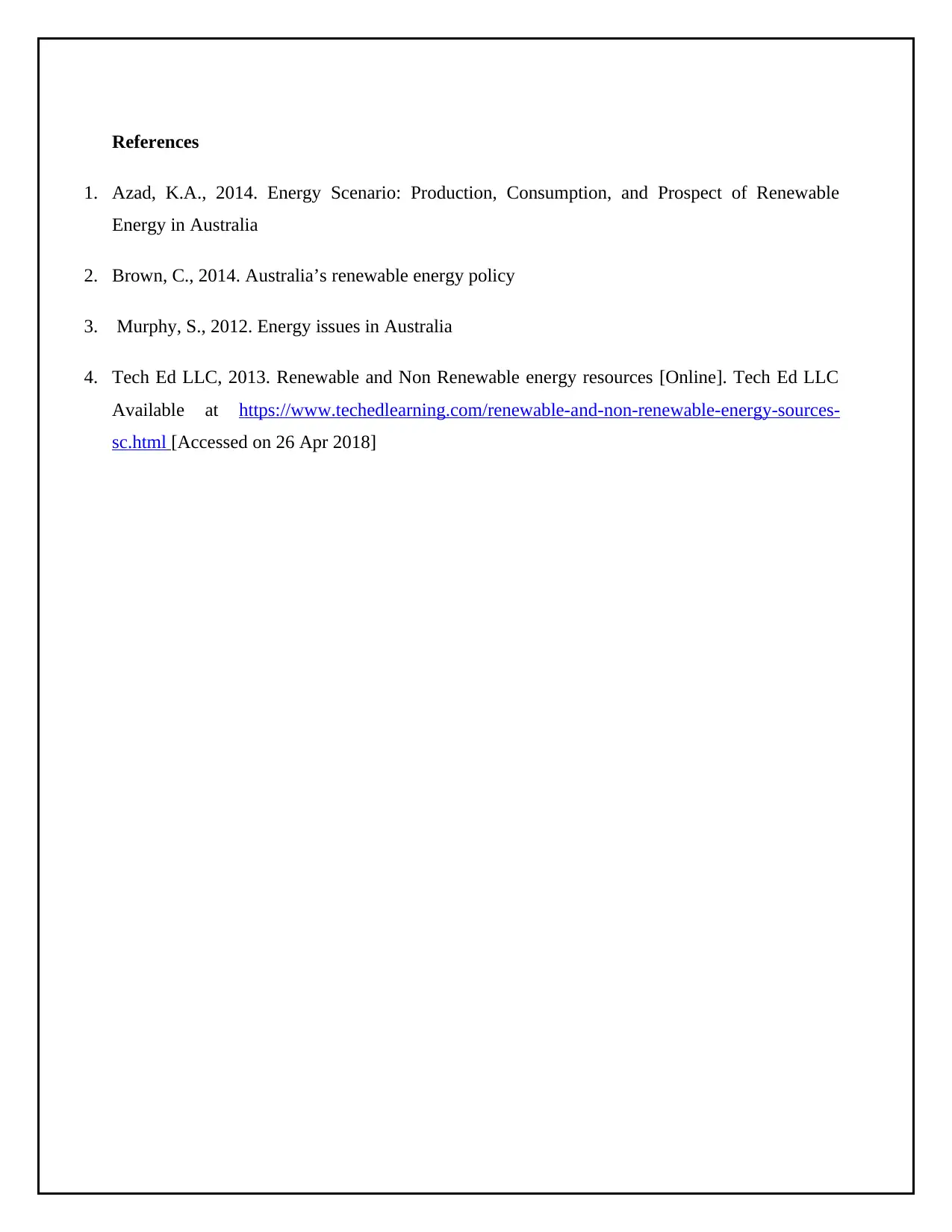
References
1. Azad, K.A., 2014. Energy Scenario: Production, Consumption, and Prospect of Renewable
Energy in Australia
2. Brown, C., 2014. Australia’s renewable energy policy
3. Murphy, S., 2012. Energy issues in Australia
4. Tech Ed LLC, 2013. Renewable and Non Renewable energy resources [Online]. Tech Ed LLC
Available at https://www.techedlearning.com/renewable-and-non-renewable-energy-sources-
sc.html [Accessed on 26 Apr 2018]
1. Azad, K.A., 2014. Energy Scenario: Production, Consumption, and Prospect of Renewable
Energy in Australia
2. Brown, C., 2014. Australia’s renewable energy policy
3. Murphy, S., 2012. Energy issues in Australia
4. Tech Ed LLC, 2013. Renewable and Non Renewable energy resources [Online]. Tech Ed LLC
Available at https://www.techedlearning.com/renewable-and-non-renewable-energy-sources-
sc.html [Accessed on 26 Apr 2018]
1 out of 10
Related Documents
Your All-in-One AI-Powered Toolkit for Academic Success.
+13062052269
info@desklib.com
Available 24*7 on WhatsApp / Email
![[object Object]](/_next/static/media/star-bottom.7253800d.svg)
Unlock your academic potential
© 2024 | Zucol Services PVT LTD | All rights reserved.




